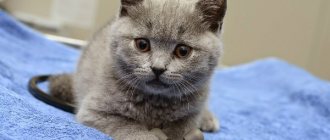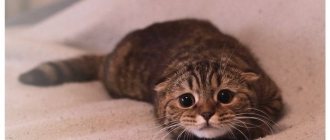At around 7-11 years of age, cats begin to show the first signs of aging. These include deafness and blurred vision. This may indicate the presence of serious health problems, or simply irreversible age-related changes. Treating the problems of older animals can greatly improve their quality of life.
Hearing loss is a fairly common symptom in an aging cat. Usually the changes occur gradually and the owner notices the problem only when the cat is completely deaf.
Some breeds have a genetic predisposition to developing deafness. They are usually cats with white fur and blue eyes. In this case, the kitten is born deaf, and the owner notices the problem at an early age. Hereditary predisposition has been noted in Persian cats, Ragdolls, Angora cats, Maine Coons, and Cornish cats.
Deafness in cats: basic information
All types of deafness (regardless of their etiology) can be divided into two large groups:
- Primary (most often it is congenital). In these cases, hearing loss develops “on its own,” most often due to some genetic reasons, the animal’s initial predisposition to this pathology.
- Secondary. In practice it is most common (with the exception of some breeds suffering from the primary variety). It is a consequence of hundreds of different diseases that in one way or another affect the condition of the animal’s hearing organs. This includes both “simple” injuries and neurological pathologies (including especially “successful” attacks of epilepsy).
How to tell if your cat has hearing problems
So, how do we as owners know if our pet has a hearing problem? In fact, it is not very easy to notice that a cat is completely deaf, because it seeks to compensate for the lack of ability to hear at the expense of other senses available to it. However, if you are very careful, you will still be able to notice that something is wrong.
So, deaf cat:
- She does not respond to the owner’s call, and not only does she not know her name, but she does not even respond to the classic “kitty-kitty.”
- The cat's behavior is somewhat nervous, she is excessively timid and often shudders, without any apparent reason.
- Since the cat cannot hear itself, it meows very loudly.
- Often the cat falls into a state of confusion and seems to lose the ability to navigate in space.
- If deafness is acquired and caused by an infectious disease, an inflammatory process or a foreign body in the ear, the cat may shake its head, rub its ears with its paws, an unpleasant odor may emanate from its ears, discharge may be observed, and the skin in the ear area begins to peel...
Based on these behavioral signs and symptoms, you can determine that something is wrong with your animal's hearing. A veterinarian will be able to make an accurate diagnosis after a complete examination of the animal.
Symptoms of the disease
Cats adapt well to their condition at the expense of their other senses. There is a certain belief that their sensitivity is so heightened that they hear by perceiving sound vibrations in the bones of the skeleton and vibrissae. They sense movement behind them by vibrations in the air.
And yet, the onset of deafness can be determined. It is usually accompanied by the following symptoms:
- meowing too loudly;
- lack of reaction to opening the refrigerator door or to the rustling of a bag of food;
- loss of orientation, frequent looking around;
- shaking the head, rubbing the ears with a paw;
- in case of an infectious disease or sulfur plugs, an unpleasant odor may be felt;
- The old cat doesn't respond to his name.
To confirm your suspicions, you need to make some sound at some distance from the animal. A well-hearing cat will react by turning its ears. A louder sound will cause fear and a reaction from the whole body. If these signs are not present, it means that the fears have been confirmed, and the cat cannot hear at all.
How to determine the degree of deafness?
People who decide to have a white kitten need to know all the nuances associated with the peculiarities of its development. Not all kittens are equally deaf. Before buying a new family member, you should find out what type of hearing he or she has already at the stage of selecting an applicant. After all, it may well be that not everyone is able to provide a normal life for a deaf child and teach him to understand a person.
INTERESTING TO KNOW: The danger of urolithiasis in cats
Everyone knows that kittens meow. It turns out that if a cat is deaf, then he screams in a higher voice than his brothers and sisters. To determine hearing, a simple technique is used: they create noise stimuli to which a deaf animal will not react in any way. For this purpose you can:
- clap your hands loudly;
- turn on the vacuum cleaner;
- slam the door;
- rustle with something that makes a loud sound, for example, chocolate foil or a regular bag.
Of course, if you approach a deaf cat from behind and touch its body, it will flinch in surprise. An ordinary cat reacts completely differently to the arrival of a person. Thanks to his excellent hearing, he will turn around before you approach, or will point his ears in the direction of your steps.
But still, a veterinarian can give a full guarantee that cats are deaf.
Main causes of feline deafness
As we have already written, the reasons for the disappearance or significant weakening of hearing are very diverse, but we will describe the most important ones.
Deafness after otitis media: why is this phenomenon dangerous?
Perhaps, complete or partial loss of hearing after otitis media, i.e. inflammatory process in the inner ear is one of the most common phenomena in veterinary otolaryngology. This is due to the fact that not all owners understand the potential danger of this pathology.
Important! If purulent inflammation develops in the cavity of the inner ear, accompanied by the release of pus, nothing good will come of it.
Pus is a powerful natural “solvent” that can damage and liquefy not only soft tissue, but even bones. Accordingly, after prolonged otitis media, the likelihood of hearing deterioration is extremely high.
Accordingly, it is not difficult to guess about the potential danger of this phenomenon: the hearing organs are located in close proximity to the brain. In addition, there are many blood vessels there.
If otitis media is not treated at all, deafness can become the cat’s smallest problem. He may well die from brain damage, sepsis or similar causes.
Senile hearing loss in cats
With age, pets (and pet owners) do not become healthier. In particular, the blood supply to the tissues in the hearing organs deteriorates, the eardrum becomes “flabby,” and other negative changes accumulate. Senile hearing loss occurs. Alas, nothing can be done about it; old age will take its toll in any case.
Considering that cats are animals with a fairly decent lifespan (subject to normal maintenance and feeding), their hearing begins to deteriorate no earlier than ten years of age. It happens that pets who live to be 14 or more years old hear almost nothing. True, this is not their most serious problem: by this time cats often go blind.
Causes of deafness
It may not be possible to determine immediately that a cat is losing hearing. Firstly, because this is an animal that walks on its own, and it can simply ignore its owner, perfectly hearing its name. Secondly, cat whiskers allow animals to feel vibration. This does not compensate for the hearing defect, but allows the cat to react to movement from behind by sensing the vibration of air masses.
If the owner suspects that his pet has begun to lose hearing, it is recommended to conduct several simple tests and observations of the cat. If the owner can notice several or most of the following signs in their pet, the cat may be losing hearing.
The main secondary symptoms accompanying hearing loss are as follows:
- the cat stopped responding to its own name;
- when an animal meows, it raises its voice, which was not the case before;
- the pet is too timid, often shudders for no reason;
- the animal is often confused, looks around, loses orientation;
- shakes his head and actively rubs his ear;
- there is a bad smell from the ears, there is discharge and the skin in the area of the auricle is peeling;
- The cat often freezes, crouches, presses its ears to its head and remains in this position.
To check their suspicions, experienced breeders recommend standing out of sight of the animal and calling it, then knocking, whistling, and making sounds of varying strength and frequency. The cat usually reacts to quiet sounds by turning its ears. When there are sharp and loud sounds, the animal bends down, presses its ears and freezes, and may look back in fear or jump away. If a cat doesn't respond to sounds, it means it can't hear them. You just need to remember that four-legged companions feel vibration very well. Therefore, when conducting such a test, you should not get too close to your pet or actively stomp.
There are many reasons for hearing loss: they can be congenital (developmental anomalies), acquired as a result of a cat’s life (due to injury, aging) or be a consequence of some disease.
It is necessary to find out the cause of hearing loss because:
timely treatment of the disease can prevent the process;
if the issue is a physiological process, then the life of the cat and its owner can be “reconfigured.”
All causes of hearing loss in animals can be divided into several groups. The main ones are infectious diseases, cancer, traumatic damage to the eardrum or brain structures, poisoning that affects the functioning of the nervous system.
Let's look at the main causes of hearing loss in animals.
Congenital deafness
Congenital deafness is observed in white and blue-eyed cats. Although this does not always happen.
Also, a cat may be born deaf due to toxic damage to the mother’s body during pregnancy. In this case, developmental anomalies may affect not only hearing, but also other body systems.
Deafness can develop in the first week of a kitten's life as a result of illness or injury.
Physiological processes
The aging process in animals is often not very different from human aging. As a rule, the auditory nerve in animals stops functioning or the bones grow together. This type of hearing loss begins gradually: at first, the cat’s hearing is not so acute, then only the loudest sounds can be heard, and at the last stage (usually in old age) complete deafness occurs.
Infectious and parasitic diseases
With infectious inflammatory processes affecting the outer and middle ear, the cat experiences severe pain, does not allow touching the ear area, an unpleasant odor appears, and appetite may be impaired. With untreated otitis media, the animal may lose hearing and die as a result of infection entering the brain.
When parasitized by ear mites, a wax plug forms in the animal's ear, which leads to hearing loss. The animal actively scratches its ears due to severe itching. In the auricle, the owner discovers a brown-black discharge consisting of dried blood and tick excrement.
Metabolic disorders
A “bouquet” of metabolic disorders, coupled with helminthic infestation, can cause increased production of earwax, the formation of ear plugs and severe hearing impairment in the animal.
Traumatic lesions
As a result of TBI, the functioning of the central nervous system can be disrupted, which causes hearing loss in animals.
As a result of a rupture of the eardrum, hearing loss can be complete (in the case of a complete rupture) or partial, with hearing restoration in the case of a small perforation. Damage to the eardrum can occur as a result of a blow to the head, a fall from a great height, exposure to a shock wave, or a puncture of the eardrum when cleaning the ears.
Oncological diseases
Brain tumors can mechanically compress the brain centers responsible for hearing. As a result, the animal becomes deaf. When tumors develop in brain structures, other symptoms are usually observed: unsteadiness of gait, inability of the animal to jump on a stool, vomiting, behavioral changes (lethargy or aggression).
Poisoning
Long-term use of medications that have ototoxic properties: antibiotics, antiseptics, cytostatics, diuretics can cause a sharp decrease in the cat’s hearing. Poisoning with arsenic, lead or mercury salts can lead to the same result.
What determines the white-blue-eyed combination?
The culprit, if you can call the unusual beautiful combination of eye color and coat color, is the melanocyte pigment. A high percentage of this substance gives the eyes a green or brown color. In this case, the percentage of melanocyte content is low, since its paired gene “worked hard” for the snow-white coat color. As a result, there is not enough pigment for eye color.
Interesting! Albino cats should not be confused with representatives of snow-white breeds. Albino animals lack color genes. Albino cats are extremely rare: one animal per 10,000 cats.
How to check if a cat can hear
At home, you can independently test your animal for hearing loss. To do this, it is enough to make a sharp loud sound. A healthy cat will certainly turn around and give a reaction. A deaf cat will not react to a stimulus. To be sure, the animal should not see you; if your hearing is impaired, cats may react not to noise, but to your hand movements or vibrations in the air. The reliability of this method is 95%. If the situation for the cat is very familiar, he sleeps soundly and does not have a fearful disposition, then the faucet may be reluctant to respond to the sound.
You can only get accurate information about whether your pet is deaf at a veterinary clinic. And even then not in every one. To date, a medical test has been developed, which is carried out using special equipment. During its implementation, the frequency and intensity of nerve impulses in the brain that appear as a result of sound exposure are measured. In cats that cannot hear noise, such impulses are completely absent, which proves the presence of deafness. Diagnosis is carried out very rarely; owners often determine the lack of hearing in cats at home quite accurately.
Is it true that white cats with blue eyes are more likely to be deaf?
This statement may seem like a “horror story,” but in fact this opinion is a very real reflection of reality. Yes, white cats with blue eyes are much more likely than their “polychrome” relatives to be deaf from birth. In addition, they are more likely to become deaf in adulthood.
This is due to recessive genes, which in some animals are associated with either the white color or the blue color of the iris. It is for this reason that many professional breeders prefer not to allow pets with this coloring into breeding.
Interesting! There is an official concept, “white cat deafness.” In such animals, some parts of the inner ear are either not developed at all, or they degrade when the cat is not yet three years old.
Interesting fact. In blue-eyed and white cats, it often happens that one eye has a more pronounced and rich color of the iris. So here it is. It is not known exactly why this happens, but deafness is often caused by the ear on the side of the more “colored” eye. The ear on the opposite side either hears or retains the ability to perceive at least the loudest sounds.
Angora cat and congenital deafness
In principle, we have already described the essence of the problem above. Although not every Angora cat is white (this color is not even the official breed standard), but still “deafness of white cats” is extremely common among them. True, this applies more to animals with blue eyes. Angoras with yellow irises suffer from congenital hearing loss much less frequently.
Important! Deafness can be a sign of an extremely dangerous breed disease, ataxia of Angora cats. It is accompanied by very severe neurodegenerative processes, which often lead to complete or partial paralysis. So, if there is any suspicion of deafness, it is useful to show Angora cats to a veterinarian.
Scottish Fold cats and deafness
Unfortunately, Scottish Folds also often suffer from congenital hearing loss. And if in the case of Angora pets the reason lies in the underdevelopment of some parts of the inner ear, then in the case of the Scots the problem lies in anatomical defects in their development.
Small, neat, slightly “dangling” ears are considered the standard of the breed. Breeders achieved such results through many years of very painstaking selection... as a result of which the genes of numerous hereditary diseases linked with the genes of the “correct” ears.
Diagnostics
Hearing loss usually occurs as a result of damage to components of the ear: the eardrum, middle or inner ear structures, and nerves. It can also be a consequence of illness or aging.
Cats that experience hearing loss are called "always sleepers," meaning loud, medium, or even soft noises may not wake him up. If your cat usually wakes up as soon as she hears your footsteps, try to see how close you need to get to the cat in order for her to react in response to your presence. If she only reacts when you touch her, this may be a sign of a hearing problem. Another example: If your cat doesn't come when you try to call him from another room, the problem may be related to possible hearing loss rather than one of the classic cat ways of testing your patience.
Diagnoses can usually be formulated through observation, but a veterinarian can accurately diagnose hearing loss using the BAER (Brainstem Auditory) test. The procedure is painless and takes 10-15 minutes. The veterinarian will apply an acoustic stimulus to each ear separately, using headphones or a foam insert. Computers will then record the changes in electrical activity in the brain caused by each acoustic stimulus. The relationship between electrical potential and anatomical structure allows for the presence of possible lesions in the acoustic pathway to be identified with considerable accuracy. Thus, this test allows for early detection of subclinical lesions (that is, those that do not show visible symptoms) in the auditory system.
Many cats diagnosed with hearing loss can still live happy lives. In fact, they can easily learn to respond to gestures, facial expressions, or even light signals. Therefore, it will be necessary to change the methods of interaction with the cat, but there are many successful cases.
In our pet hotel “Pets in Joy” we are ready to accept cats even with such disabilities and diseases as deafness. The staff will treat such guests with the utmost care.
Treatment of the disease
Treatment methods for deafness vary depending on the causes that cause it:
We can say that congenital deafness is not a pathology, but a feature of the white color. Since the animal is born deaf, it does not adapt, but lives, from birth actively including the other senses (vision, touch and smell). Therefore, caring for such kittens is practically no different from caring for their healthy counterparts.
White cats are extremely popular among cat lovers, so they are bred despite the risks. But this process should be controlled by an experienced breeder. Errors in the selection of pairs threaten that deafness, as a genetic trait, may manifest itself in the offspring. In addition, there is a high probability that sickly and non-viable offspring will be obtained.
There are several specific features of keeping deaf pets:
- One of the main conditions is that such cats should not be allowed to go outside alone, as they are more exposed to various dangers than others.
- You should not approach the cat from behind, so as not to scare it. As a last resort, when entering, you can slam the door louder or stomp, creating vibrations that are clearly felt by the animal.
- They can read lips, so it is necessary to address her in such a way that she sees the owner’s face.
- You need to be extremely careful when being in the same room with a deaf pet so as not to step on it.
Deafness is not a reason to throw your furry pet out onto the street or euthanize it. With careful attention, love and care, this deficiency will not be noticeable to either the owner or his pet.
Many white, blue-eyed cats are born deaf, however, not all are born deaf. This does not apply to the Burmese and Siamese breeds, which are light in color and have blue eyes. Many cats with different colored eyes - blue and yellow - are also prone to deafness.
The cause of deafness is a genetic defect
. Each animal has two genes for each trait, one from the mother and one from the father. As for hearing, if the mother passes on the deafness gene and the father does not, then the deafness gene is dominant and the kitten is born deaf.
There is an organ in a cat's ear that converts sound waves into electrical impulses that travel to the brain as sound. With such a genetic defect, the organ responsible for converting sound waves begins to degrade at approximately 5 days of age. Since the ear canal of a normal kitten does not open until 6 to 14 days of age, a kitten with a similar genetic defect will not hear a single sound in its life.
The same gene affects a cat's eyes, reducing their ability to see at night, which negatively affects the cat's hunting abilities.
As with other deaf animals, deaf cats are prone to accidents, are more vocal, and can be more aggressive. Deaf cats require special care. They must remain indoors and should not be allowed to roam free. Also, to prevent the transmission of this gene to future generations, it is strongly recommended not to use deaf cats or male cats for breeding.
braniac Per. from English Natalie Thai, Thai Cat Club
Living with a deaf cat may seem quite difficult from afar, but you don't know how adaptable cats are to life, especially when they don't know that they are any different from other cats.
Photo by falafelicious, USA
Features of congenital deafness
Many owners know the fact that white cats with blue eyes often have a congenital defect such as deafness. Such cats have a special dominant W gene in their genotype. It is the presence of this gene that makes the likelihood that a white cat will be deaf very high. In some cases it reaches 80%. In turn, congenital deafness in individuals of a different color is an extremely rare phenomenon.
The dominant W gene is pleiotropic, that is, it is responsible for the presence of several traits at once. In addition to white coat color and deafness, it also makes blue eye color dominant. The probability of deafness among white individuals is distributed as follows:
- animals with blue eyes are deaf in 80% of cases;
- animals with heterochromic eyes (one eye is blue and the other is a different color) are deaf in 40% of cases;
- animals with eyes of any color (except blue) are deaf in 20% of cases.
It has been noted that deafness in white cats, caused by the presence of this gene, can be either unilateral or bilateral (long-haired beauties most often suffer from it).
How does deafness develop in white individuals?
It is known that absolutely all kittens are born deaf, with closed ear canals. By the age of 5-7 days they gradually open. At the age of two weeks, the kitten is able to determine the direction of a sound, and by a month, it can already distinguish sounds. In a white kitten, due to genetic disorders, by the time the ears open (at a week of age), the organ of Corti, the receptor part of the auditory analyzer, located in the auditory labyrinth and responsible for analyzing sound signals, atrophies.
Features of natural and artificial selection of white cats
In the wild, white cats survive much less often than others, since they turn out to be much less adapted to the unfavorable factors of the surrounding reality. The reasons for this are as follows:
- high probability of deafness;
- photophobia, which is promoted by a light shade of the eyes;
- poor vision in low light conditions.
In conditions of artificial breeding, white cats are very popular because they have an attractive appearance. They are actively bred, despite the high likelihood of physical defects.
Prevention and care of the ears: how to prevent the development of deafness
High-quality ear prevention and care will help the owner preserve the pet’s hearing.
You don’t have to do anything particularly complicated for this:
- It is necessary to examine the inside of the ears and the external auditory canal approximately once a week. If sulfur begins to accumulate there, it must be removed. To do this, use ordinary cotton swabs moistened with sterile vegetable or petroleum jelly. At worst, even saline solution (also sterile) will do. All liquids must be heated to approximately 37° Celsius before use.
- If a cat constantly scratches and scratches its ears, and abundant brown deposits are easily visible on the pinnas and in the ear canals themselves, you should immediately treat your pet for otodectosis (ear mites). These parasites often cause severe allergic reactions and, in advanced cases, contribute to the development of severe otitis media. Before using ear drops, you should also carefully remove mite waste in the same way as with regular ear cleaning.
- In long-haired cats, excess hair around the ears should be trimmed periodically. This promotes better ventilation of the ear canals, which prevents the creation of favorable conditions for parasites and pathogenic fungi.
Tarnished Reputation
White cats, and especially long-haired white cats, are called by breeders not for lazy people. And it is important to realize this point even before purchasing, since there is nothing more pathetic than dirty, matted fur of an indistinct shade. White cats completely ignore blind partitions, closed doors and strict prohibitions: if there is dirt in the house, she will find it, smear herself and appear before the owner, looking at him with the most innocent look. It is useless to scold, and even more so to wean the cat from exploring the territory. A white cat in the house is a serious reason to maintain perfect cleanliness.
However, you should not think that a snow-white cat is a kind of dust collector. If the pet is healthy and the owner does not forget to take care of the fur, there will be much fewer problems. As a rule, the “revealing” places are the heels, base of the tail, chest, muzzle and base of the ears. In these areas, the fur often takes on a yellowish or grayish tint, even if the house is sterilely clean. Therefore, caring for a white cat necessarily includes bathing with the use of special shampoos, pastes and powders. Cosmetics must be professional, and therefore not cheap. A cheap whitening shampoo can burn the fur and turn it a “cheerful” bluish or greenish tint.
In Ancient Rus' there was even a sign about what a white cat in a soiled fur coat means in a dream: slander, a tarnished reputation, gossip, unsightly rumors. And really, what will guests think when they see a grimy, once snow-white cat? It is doubtful that they will consider the owners to be neat, loving and caring people.
Proper handling of a deaf cat
Deaf cats usually behave like their hearing cats and do not feel inferior. If the animal does not sense danger, then it behaves friendly and devotedly. The task of the owner of a special cat is to ensure its complete safety and learn to communicate.
A deaf cat cannot hear, but at the same time perfectly detects vibrations and vibrations. However, keep in mind that your silent appearance in the room will frighten the animal. A similar reaction will be caused by sharp vibrations of sounds. Because to prevent the cat from being scared by your approach, start stomping harder from afar. Do not approach her from behind - try to get into the pet’s field of vision before approaching. Behave the same way if you intend to stroke it. The cat must see the hand approaching it and only then feel the touch.
If an animal is constantly “attacked” unexpectedly, it will become aggressive and begin to fight back.
When interacting with a deaf animal, attract its attention by loud clapping or knocking on the floor. The cat will pick up the vibrations and understand where they are coming from.
If in this case the pet ignores you, this is a conscious choice. Inventive owners of deaf cats attract the pet's attention with light signals, for example, turning on a small flashlight.
Notes
- 1 2 Observations on the Histological Features, Development and Pathogenesis of the Inner Ear Degeneration of the Deaf White Cat
- A model for prelingual deafness, the congenital deaf white cat -population statistics and degenerative changes
- Cornish Rex. Development and mutations. Retrieved October 10, 2010. Archived July 1, 2012.
- I. Shustrova. BASICS OF GENERAL GENETICS. INTERACTION OF ALLELES.. Nursery “Catherine”. Retrieved October 10, 2010. Archived July 1, 2012. All kittens from this crossing will be white, and in the second generation colored kittens will also appear. But what is curious is that among these kittens, blue-eyed and deaf will only be found among white offspring. Moreover, among them there may be those who are blue-eyed in one eye (or deaf in one ear). And nothing like this will be found among colored kittens. It turns out that the dominant W allele of the white color gene determines not only color, but also deafness and eye color. This phenomenon - the influence of one gene on several traits - is called pleiotropy. By the way, the split among white kittens into blue-eyed, different-eyed and yellow-eyed, deaf and normal: hearing ones will not be Mendelian at all.
- Feline Health Center. Ask Elizabeth (English) (unavailable link). Cornell University Feline Health Center. Retrieved October 22, 2010. Archived December 26, 2008. Researchers found that only 17 to 22 percent of white cats with non-blue eyes are born deaf. The percentage rises to 40 percent if the cat has one blue eye, while upwards of 65 to 85 percent of all-white cats with both blue eyes are deaf. Some of these cats are deaf in only one ear. Interestingly, if a white cat with one blue eye is deaf in only one ear, that ear will invariably be on the same side of the head as the blue eye.
- Cornish Rex. Development and mutations. Retrieved October 10, 2010. Archived July 1, 2012. Apparently, the W mutation disrupts the ability to migrate not only melanoblasts, but also some other cells differentiating in the area of the neural tube of the embryo. The connection between white coat color, blue eye color and deafness was noted by Darwin. Although it must be said that such pleiotropic effects of the W gene, such as blue eyes and deafness, do not appear in all its carriers.
>Deaf white cats.
Additional information: Deafness in cats. Permanent and temporary deafness. Ears of a domestic cat.
Why are white cats deaf?
Deafness in white cats is explained by certain genetic characteristics. The white color gene, which is dominant, specifically affects the processes that occur in a small organism at the stage of embryonic development, and it also affects the development of hearing. This has been proven through numerous experiments.
If the kitten has Siamese cats or Thais in its family, then the presence of blue eyes does not fully guarantee that the grown cat will be deaf. This is explained by the fact that the gene with this pathology was taken from Siamese cats that do not have this problem.
How to communicate with such a cat?
Of course, keeping deaf cats has its own characteristics. Owners will have to get used to the fact that much of the behavior of such animals will be unusual for them. They will never be able to successfully hunt birds. They won’t make hunters, because you can’t explain to a cat that a bird hears when someone is creeping up on it. This means you need to sneak up on her as quietly as possible.
How to find out if your kitten or cat is deaf
If the hearing function is impaired in both ears, then this becomes immediately noticeable in the cat’s behavior. She sleeps soundly, without twitching her ears in her sleep. Such animals do not react to noise in any way and are not afraid of loud sounds. They are left indifferent to opening the refrigerator door and opening a bag of food. Even the thunderstorm of many pets does not cause them fear of a vacuum cleaner; on the contrary, deaf pussies even like the air currents it creates. The same signs appear in older cats, but this is caused by senile deafness.
It is believed that cats with hearing loss meow too loudly because they cannot regulate the strength of their voice. But this is not always a sign of deafness.
Interesting! The sound ranges of humans and cats vary greatly. While humans can hear sounds between 20 Hz and 20 kHz, cats hear sounds between 48 Hz and 85 kHz.










